- By Dan Veaner
- News
 Print
Print 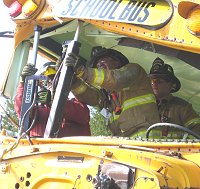 One of the most striking images of the August 1 Interstate 35W bridge collapsed in Minneapolis was a yellow school bus on the brink of a chasm that meant the difference between surviving and plunging into the Mississippi River.
One of the most striking images of the August 1 Interstate 35W bridge collapsed in Minneapolis was a yellow school bus on the brink of a chasm that meant the difference between surviving and plunging into the Mississippi River. Last weekend Lansing Fire Department volunteers spent a morning training to get kids out of a bus if the worst happens. The department bought a used Lansing School bus from an individual who owned it, and lifted one wheel onto a car. "We made a scenario of a car that ran under a bus," explains Chief Scott Purcell. "We're working on multiple ways of getting into a bus using different techniques and theories using different tools to access the bus."
The four hour training session was conducted by Churchville Fire Equipment 's Kevin Romer. The company sells equipment to fire departments, and offers the training as well. A firefighter himself, Romer has actually used the techniques he teaches in real bus accidents. "Because of the amount of training sessions that I do, I know what works and what doesn't," he says.
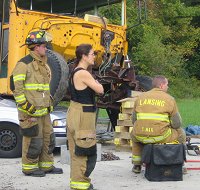
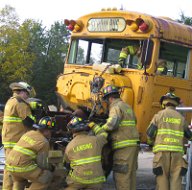
Firefighters (left) get tips from Romer and later jack the bus onto
wooden blocks so they can get the car out from underneath
 Romer says his company offers the training for any fire company that asks for it in New York State and Pensylvannia. This bus was not ideal because it had no seats. Romer says that if it had seats it would better simulate the crowded conditions on a real bus, and would give the trainees a chance to remove them to make more room, as well as creating access points to the outside.
Romer says his company offers the training for any fire company that asks for it in New York State and Pensylvannia. This bus was not ideal because it had no seats. Romer says that if it had seats it would better simulate the crowded conditions on a real bus, and would give the trainees a chance to remove them to make more room, as well as creating access points to the outside. But he says that there is plenty to learn no matter what the configuration of the training vehicle. "You play the deck of cards as it's dealt to you and you play the hand you've got," he notes. "Just because it's a bus with no seats, in the real world it doesn't have to be a bus with no seats. It could be somebody's camper, somebody's race-car hauler. It's the same whether it's painted yellow or something different."
About a dozen Lansing volunteers were in full gear for the exercise. They worked on the bus for a while, and during stopping points analyzed what went right and what went wrong. At one point the discussion focussed on an error that caused one of the tools that is part of the 'Jaws of Life,' to hemorage oil. 'Jaws of Life' is a brand name belonging to the Hurst company, which manufactures the hydraulic tool made up of cutters, spreaders, and rams used for accessing and cutting apart vehicles to get victims out quickly. Deputy Chief Brad George was frustrated, because some firefighters had watched others use the tool incorrectly but didn't say anything until it was too late. But Romer says this kind of thing is good in a training session, because it gives firefighters a chance to learn from mistakes and work out the best procedures while actual lives are not at stake. "It's better for it to happen here than to happen out there," he notes.
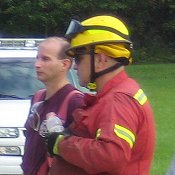
Kevin Romer
Firefighters take a break to analyze what they have done so far and
offer suggestions on how to improve
Half way into the session a number of access points had been cut into the bus, and three trainees worked at folding the front of the top of the bus up, like opening a giant can of sardines. A few more cut a hole in one side of the bus, while other firefighters accessed the other side using ladders to get to smaller holes they had cut there. "It's hot and sunny," Romer noted. "That makes it hard. This is pretty labor-intensive training, it's tough to do especially when they're wearing the amount of gear that they're wearing."
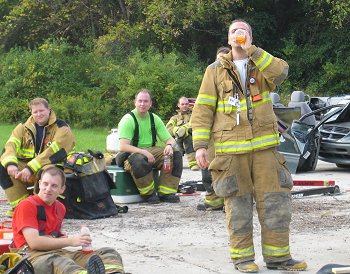
Purcell says that department volunteers, men and women, train twice a month, and that they focus on extrication training a few times a year. By the end of the morning there were plenty of holes in the bus, some of them very large. If a bus ever does crash in Lansing, department volunteers will be ready.
----
v3i39



